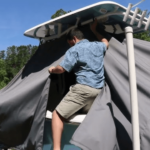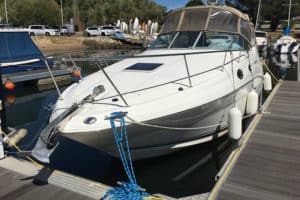Starting an inboard boat engine out of water can be a daunting task for beginners, but it is a necessary skill for any boat owner.
An inboard boat engine is a complex piece of machinery that requires proper care and maintenance.
One of the most important aspects of engine maintenance is to ensure that the engine is started and run regularly, even when the boat is not in the water.
To start an inboard boat engine out of water, it is important to follow a few simple steps. The first step is to lower the engine, but make sure that it is in a vertical position.
Next, locate the engine intakes and attach motor flusher muffs and a hose. If the intakes do not have built-in attachments for a garden hose, then a set of motor muffs will be required.
Once the motor flusher muffs and hose are attached, turn on the water and start the engine. It is important to monitor the engine temperature gauge to ensure that the engine does not overheat.
Running the engine out of water for too long can cause serious damage to the engine, so it is important to only run the engine for a short period of time.
By following these simple steps, anyone can safely start an inboard boat engine out of water.
Preparing the Inboard Engine

Before starting an inboard boat engine out of water, it is important to prepare the engine properly. This involves checking the engine type and gathering necessary equipment.
Checking the Engine Type
The first step in preparing an inboard engine is to determine the type of engine. Inboard engines are typically located inside the boat, while outboard engines are attached to the transom. It is important to know the engine type to ensure that the correct procedures are followed for starting the engine out of water.
Gathering Necessary Equipment
Once the engine type has been determined, the next step is to gather the necessary equipment. This includes a motor flusher, which is used to supply water to the engine for out-of-water situations. Inboard and outboard engines use different kinds of flushers, so it is important to ensure that the correct flusher is used.
In addition to a motor flusher, a garden hose and a water supply are also necessary. The garden hose is connected to the motor flusher, while the water supply is used to provide water to the garden hose.
It is also important to consult the owner’s manual to ensure that all necessary steps are followed for starting the engine out of water. The manual contains important information about the engine and provides instructions for starting the engine safely and effectively.
Setting Up the Water Supply

Before starting an inboard boat engine out of water, it is important to set up a water supply to ensure that the engine is properly cooled. There are a few ways to set up the water supply, depending on the equipment available.
Connecting to a Garden Hose
One way to set up the water supply is by connecting the inboard boat engine to a garden hose. To do this, the boat owner needs to attach a hose to the water intake on the lower unit of the engine. The hose should be connected to a water source, such as a spigot or faucet.
Using a Motor Flusher Muffs
Another way to set up the water supply is by using a motor flusher muffs. This tool is designed to look like ear muffs so that it can firmly attach itself to the inlet vents on the motor. The inlet vent is what sucks the water in to cool off the engine while it is running.
The boat owner needs to attach the motor flusher muffs and a hose to the inboard boat engine. The hose should be connected to a water source, such as a spigot or faucet.
Employing a Fake-A-Lake Device
A third way to set up the water supply is by employing a Fake-A-Lake device. This device is designed to mimic the pressure of water when the boat is in the water. The boat owner needs to attach the Fake-A-Lake device to the water intake on the lower unit of the engine. The device has a hose attachment that should be connected to a water source, such as a spigot or faucet.
Regardless of the method used to set up the water supply, it is important to make sure that the water is flowing through the engine before starting it. This will help ensure that the engine is properly cooled and will prevent damage to the engine.
Starting the Engine
Starting an inboard boat engine out of water requires a few extra steps to ensure that the engine is not damaged. Before starting the engine, make sure the boat is on a level surface and the drive is in the down position.
Turning the Key
To start the engine, insert the key into the ignition and turn it to the “on” position. Wait for the engine to complete its self-check before turning the key to the “start” position. The engine should start within a few seconds.
Monitoring the Temperature Gauge
Once the engine is running, monitor the temperature gauge closely. If the temperature rises above the normal operating range, shut off the engine immediately. Running the engine without water can cause it to overheat and sustain damage.
It is important to note that starting an inboard boat engine out of water should only be done for short periods of time. Extended periods of running the engine without water can cause serious damage to the engine. Always follow the manufacturer’s instructions for starting and running the engine out of water.
Post-Start Checks and Maintenance

Once the inboard boat engine has been started out of the water, it is important to conduct post-start checks and maintenance to ensure that everything is working properly and to prevent any potential issues from arising.
Inspecting for Water Leakage
After starting the engine out of water, it is important to inspect the bilge area for any signs of water leakage. It is normal for some water to accumulate in the bilge area, but excessive water could indicate a problem with the cooling system or other components of the engine.
To inspect for water leakage, the boat owner can use a flashlight to check the bilge area for any standing water or signs of moisture. If water is present, the boat owner should investigate the source of the leak and take appropriate action to fix the problem.
Assessing the Cooling System
The cooling system is an essential component of an inboard boat engine, and it is important to ensure that it is functioning properly after starting the engine out of water.
To assess the cooling system, the boat owner can check the water flow from the exhaust system. If there is a steady flow of water, it indicates that the cooling system is working properly. If there is no water flow or the flow is intermittent, it could indicate a problem with the water pump or other components of the cooling system.
In addition to these checks, it is important to conduct regular maintenance on the inboard boat engine, including routine maintenance of the cooling system and water pump. This can help prevent problems from arising and ensure that the engine runs smoothly for years to come.
Troubleshooting Common Issues
Starting an inboard boat engine out of water can be a bit tricky, and there are some common issues that can arise. Here are some troubleshooting tips to help you diagnose and fix problems that may occur:
Dealing with Overheating
One common issue that can occur when starting an inboard boat engine out of water is overheating. This can be caused by a number of factors, including a malfunctioning impeller or a lack of water flow. If you notice that your engine is overheating, there are a few things you can do to address the problem.
First, check the water flow. Make sure that water is flowing through the cooling system and that there are no obstructions or blockages. If water flow is good, then the impeller may be the culprit. Check the impeller for damage or wear, and replace it if necessary.
Addressing Water Pressure Problems
Another common issue that can occur when starting an inboard boat engine out of water is water pressure problems. This can be caused by a number of factors, including a malfunctioning water pump or a clogged intake. If you notice that there is little to no water pressure, there are a few things you can do to address the problem.
First, check the water pump. Make sure that it is working properly and that there are no leaks or damage. If the water pump is working properly, then the intake may be clogged. Check the intake for any debris or blockages, and clear them out if necessary.
In summary, troubleshooting common issues when starting an inboard boat engine out of water can be done by checking water flow, impeller, water pump, and intake. By following the tips above, you can diagnose and fix problems that may arise, ensuring that your inboard boat engine starts smoothly every time.
Final Thoughts
Starting an inboard boat engine out of water can be a tricky task, but with the right tools and knowledge, it can be done safely and efficiently. It is important to remember that starting an engine out of water should only be done for maintenance purposes and not as a regular practice.
To ensure the safety of the engine, it is recommended to follow the manufacturer’s instructions and use the appropriate tools such as a motor flusher and hose. It is also important to make sure that the engine is in neutral and the boat is securely anchored or blocked before starting the engine.
In addition, it is important to regularly maintain and service the engine to prevent any potential damage or issues. This includes checking the oil levels, changing the oil and filters, and inspecting the belts and hoses.
By following these guidelines and taking proper precautions, boaters can safely start their inboard boat engine out of water and keep their engine running smoothly for years to come.







![Read more about the article How to Drive a Boat? [10 Fundamentals]](https://boatinggeeks.com/wp-content/uploads/2020/10/how-to-drive-a-boat-300x200.jpg)

